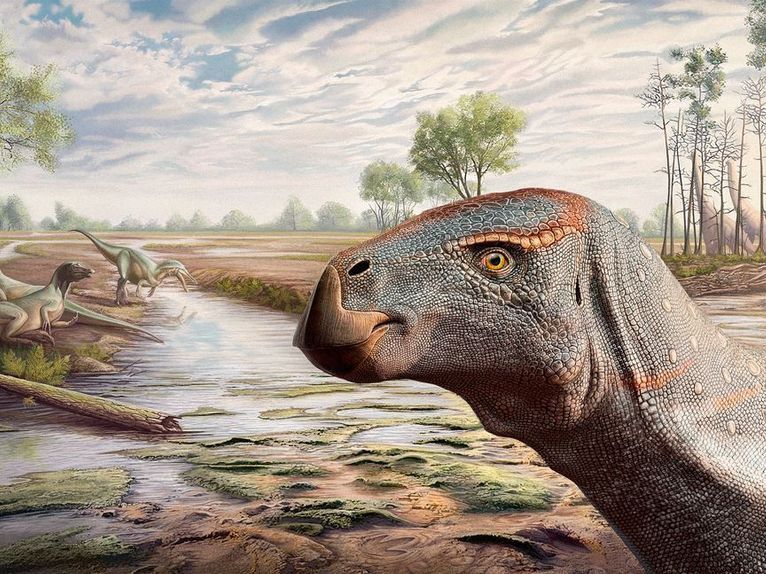The dinosaur's "rare" skull allowed the international team to describe a new species of iguanodon (herbivorous and bipedal) called 'Cariocecus bocagei,' the first named iguanodon species from the Early Cretaceous of Portugal.
"Cariocecus exhibits a unique feature among dinosaurs: the jugal bone (an area analogous to the position of the cheekbone) and the maxilla are fused, an adaptation likely designed to strengthen its chewing ability," explains one of the authors, Italian Filippo Bertozzo, of the Royal Museum of Natural Sciences in Brussels and the Natural History Society of Torres Vedras (SHN), quoted in a press release.
Please welcome Cariocecus bocagei! A new, basal hadrosauroid from the early Cret. of Portugal! This guy is known from a pretty nice skull, which makes it one of the best ornithopod fossils from Iberia so far! I loved during this little portrait for main author Filippo Bertozzo... pic.twitter.com/AzodFI5bKw
— Joschua Knüppe (@JoschuaKnuppe) September 15, 2025
Although three other iguanodontid species have been identified in the Late Jurassic of Portugal (Draconyx loureiroi, Eousdryosaurus nanohallucis, and Hesperonyx martinhotomasorum), prior to the study now published, "iguanodont fossils from the Early Cretaceous were rare, uninformative, and very primitive."
According to Bruno Camilo, also an author of the study and director of SHN, this new species "represents the most complete dinosaur skull ever found in the country."
"Because it's a juvenile or subadult specimen, it allows us to understand the timing and modalities of the co-ossification of the cranial bones during growth, which is very rare to understand in a dinosaur," adds the doctoral candidate at Instituto Superior Técnico.
The discovery contributes to a better understanding of their biology, particularly regarding the origin and diversification of these animals during the Cretaceous.
The preservation and three-dimensionality of the find allowed the digital reconstruction of the brain, cranial nerves, and, especially, the inner ear, revealing a short olfactory lobe and a large brain.
In addition to the unique cranial characteristics, American Donald Cerio, another of the study's authors and a researcher at Johns Hopkins University, highlights "fossil evidence of neurosensory structures, including the brain, ear, and eye cavities" to explain their evolution and diversity in the Early Cretaceous.
The study may contribute to the discovery of new information about dinosaur metabolism.
Deeper knowledge
"We are increasingly deepening our knowledge of dinosaurs' sensory capabilities, and the exceptional preservation of the endocranium has allowed us to better understand the details of these animals' ears and hearing," explains Ricardo Araújo, another of the authors and a researcher at the Instituto Superior Técnico and SHN.
The skull was found in 2016 on the coast of Sesimbra, in the Setúbal district, by Pedro Marrecas, co-author and researcher at the Natural History Society of Torres Vedras, where it was stored.
At Praia da Área do Mastro, the fossil was "partially visible in the rocky block, thanks to the row of protruding teeth" and required preparation and restoration work.
Other dinosaurs have been discovered in this region, but none had the characteristics necessary to be considered a new species.
In Portugal, "we have an abundant diversity of similar animals from even earlier periods, from the Upper Jurassic, but more primitive, not yet within the iguanodont lineage. Portugal proves to be an important "bridge" between these geological periods, which will allow us to unravel the secrets of the iguanodonts' evolutionary success," says Filippo Bertozzo.
The scientists named the new species "Cariocecus bocagei," in reference to the ancient war deity revered by local populations in the pre-Roman period (Cariocecus) and in honour of José Vicente Barbosa du Bocage, a 19th-century Portuguese naturalist ('bocagei').
The study is also signed by José Carlos Kullberg (New University of Lisbon), the Italian Fabio Manucci, Victor Feijó de Carvalho (SHN), Silvério D. Figueiredo (Polytechnic Institute of Tomar) and the Belgian Pascal Godefroit (Royal Institute of Natural History of Belgium).















Rumours that large numbers of these slow moving, plodding creatures have been spotted in Government offices have been refuted by Sr. Terry Dactyl of the CGTP, who made it clear the D in DEI does not stand for Dinosaur
By Nick Bowles from Beiras on 20 Sep 2025, 18:43